Evidence Based Nursing Research: PICO, Database Search & RCT Appraisal
VerifiedAdded on 2023/04/24
|21
|5697
|467
Report
AI Summary
This assignment focuses on evidence-based nursing research, utilizing the PICO framework to formulate a focused research question regarding the effectiveness of remote telemonitoring technology compared to frequent clinic visits for heart failure patients. It involves developing a search strategy, applying it in Medline and CINHAL databases, and appraising a randomized controlled trial (RCT) using the CASP tool. The report includes screenshots of database searches, abstracts of selected RCT and qualitative studies, and a detailed appraisal of the RCT's validity and results, examining the treatment effect and precision. The aim is to demonstrate the ability to acquire and critically evaluate evidence to inform clinical practice. Desklib provides past papers and solved assignments for students.
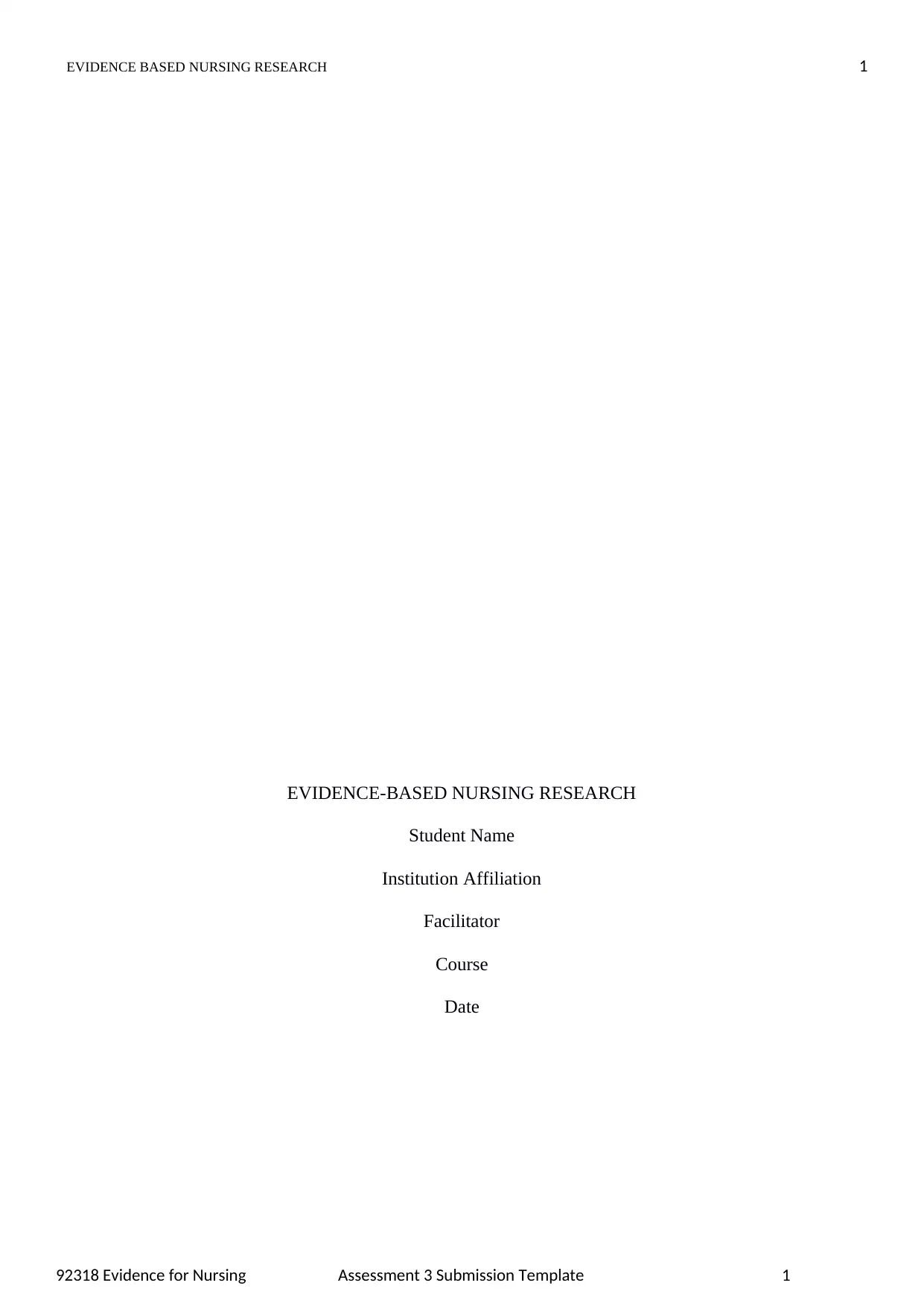
EVIDENCE BASED NURSING RESEARCH 1
EVIDENCE-BASED NURSING RESEARCH
Student Name
Institution Affiliation
Facilitator
Course
Date
92318 Evidence for Nursing Assessment 3 Submission Template 1
EVIDENCE-BASED NURSING RESEARCH
Student Name
Institution Affiliation
Facilitator
Course
Date
92318 Evidence for Nursing Assessment 3 Submission Template 1
Paraphrase This Document
Need a fresh take? Get an instant paraphrase of this document with our AI Paraphraser
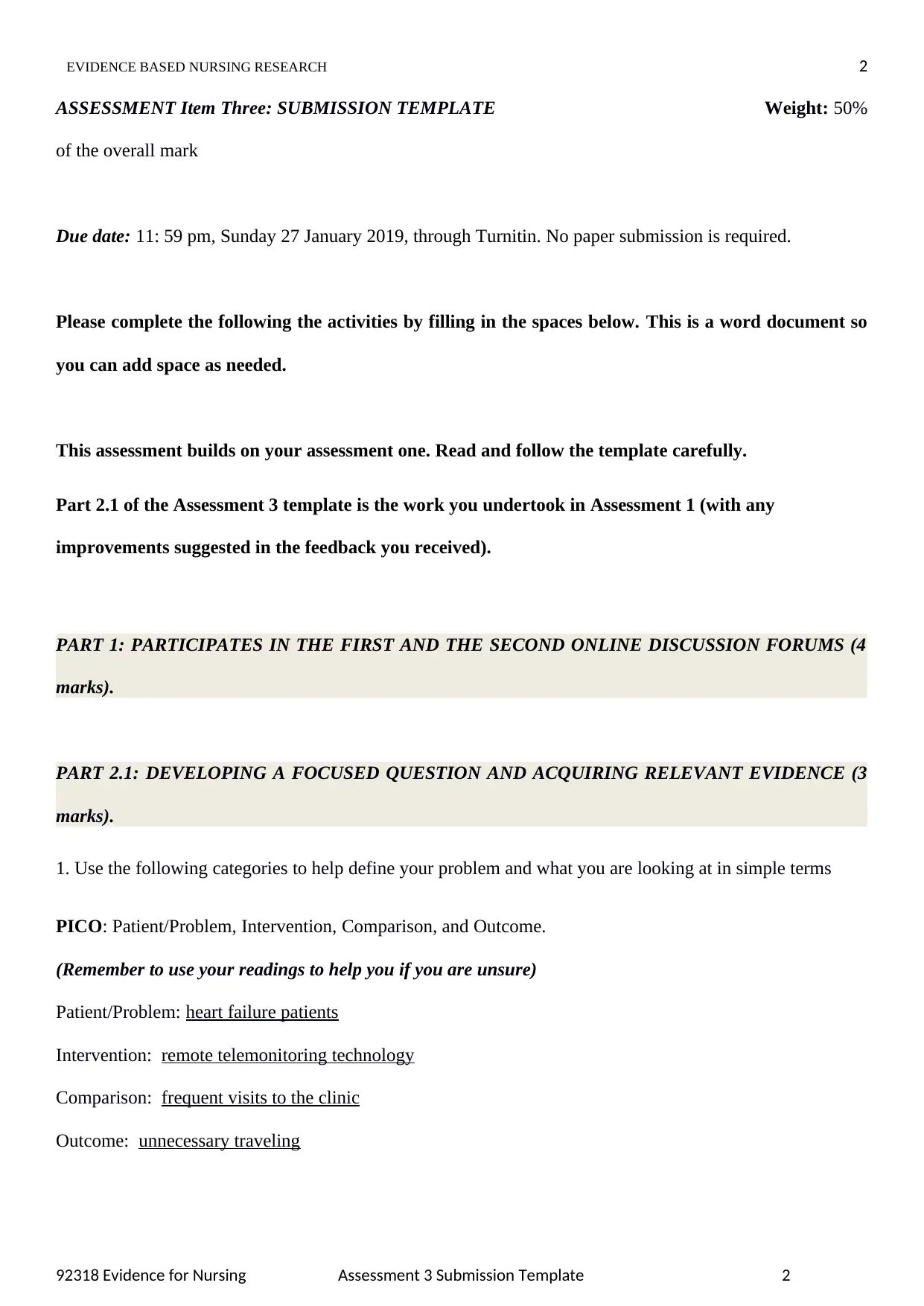
EVIDENCE BASED NURSING RESEARCH 2
ASSESSMENT Item Three: SUBMISSION TEMPLATE Weight: 50%
of the overall mark
Due date: 11: 59 pm, Sunday 27 January 2019, through Turnitin. No paper submission is required.
Please complete the following the activities by filling in the spaces below. This is a word document so
you can add space as needed.
This assessment builds on your assessment one. Read and follow the template carefully.
Part 2.1 of the Assessment 3 template is the work you undertook in Assessment 1 (with any
improvements suggested in the feedback you received).
PART 1: PARTICIPATES IN THE FIRST AND THE SECOND ONLINE DISCUSSION FORUMS (4
marks).
PART 2.1: DEVELOPING A FOCUSED QUESTION AND ACQUIRING RELEVANT EVIDENCE (3
marks).
1. Use the following categories to help define your problem and what you are looking at in simple terms
PICO: Patient/Problem, Intervention, Comparison, and Outcome.
(Remember to use your readings to help you if you are unsure)
Patient/Problem: heart failure patients
Intervention: remote telemonitoring technology
Comparison: frequent visits to the clinic
Outcome: unnecessary traveling
92318 Evidence for Nursing Assessment 3 Submission Template 2
ASSESSMENT Item Three: SUBMISSION TEMPLATE Weight: 50%
of the overall mark
Due date: 11: 59 pm, Sunday 27 January 2019, through Turnitin. No paper submission is required.
Please complete the following the activities by filling in the spaces below. This is a word document so
you can add space as needed.
This assessment builds on your assessment one. Read and follow the template carefully.
Part 2.1 of the Assessment 3 template is the work you undertook in Assessment 1 (with any
improvements suggested in the feedback you received).
PART 1: PARTICIPATES IN THE FIRST AND THE SECOND ONLINE DISCUSSION FORUMS (4
marks).
PART 2.1: DEVELOPING A FOCUSED QUESTION AND ACQUIRING RELEVANT EVIDENCE (3
marks).
1. Use the following categories to help define your problem and what you are looking at in simple terms
PICO: Patient/Problem, Intervention, Comparison, and Outcome.
(Remember to use your readings to help you if you are unsure)
Patient/Problem: heart failure patients
Intervention: remote telemonitoring technology
Comparison: frequent visits to the clinic
Outcome: unnecessary traveling
92318 Evidence for Nursing Assessment 3 Submission Template 2

EVIDENCE BASED NURSING RESEARCH 3
2. Now use these terms from the question above to create your PICO research question so that you have a
clear purpose for your search:
In (P) heart failure patients, does (I) remote telemonitoring technologies compared with (C) frequent visits to
the clinic improve/reduce (O) unnecessary traveling?
3. What type of clinical question do you think this PICO answers?
□ Therapeutic □ Aetiology □ Diagnostic √□ Prevention □ Prognosis □ Others
4. The table below will help you to think of the other terms that you might also like to look up when
searching for evidence to help you answer your question – this is part of basic planning for a research
search.
We ask you to look up alternative terms because sometimes articles from different countries and
health systems call things different names – for example, in Australia we sometimes use the term
‘community nurses’, but in the UK they often talk about ‘district nurses’ – if you only searched
under ‘district nurse’ you’d miss all the articles which happened to a different term – you would be
missing some of the pictures!
92318 Evidence for Nursing Assessment 3 Submission Template 3
2. Now use these terms from the question above to create your PICO research question so that you have a
clear purpose for your search:
In (P) heart failure patients, does (I) remote telemonitoring technologies compared with (C) frequent visits to
the clinic improve/reduce (O) unnecessary traveling?
3. What type of clinical question do you think this PICO answers?
□ Therapeutic □ Aetiology □ Diagnostic √□ Prevention □ Prognosis □ Others
4. The table below will help you to think of the other terms that you might also like to look up when
searching for evidence to help you answer your question – this is part of basic planning for a research
search.
We ask you to look up alternative terms because sometimes articles from different countries and
health systems call things different names – for example, in Australia we sometimes use the term
‘community nurses’, but in the UK they often talk about ‘district nurses’ – if you only searched
under ‘district nurse’ you’d miss all the articles which happened to a different term – you would be
missing some of the pictures!
92318 Evidence for Nursing Assessment 3 Submission Template 3
⊘ This is a preview!⊘
Do you want full access?
Subscribe today to unlock all pages.

Trusted by 1+ million students worldwide

EVIDENCE BASED NURSING RESEARCH 4
Population Intervention Comparison
(not commonly used in
actual database search
strategy)
Outcome
(not commonly used in
actual database search
strategy)
What is your population?
Heart Failure Patients:
What other terms might
have been used?
Chronic Heart Failure
patients, Heart attack
patients:
What is your
intervention?
Remote telemonitoring
technology:
What other terms might
have been used?
Remote telemonitoring
devices:
What is your
comparison? N/A:
What other terms might
have been used?
N/A:
What is your outcome?
N/A:
What other terms might
have been used?
N/A:
92318 Evidence for Nursing Assessment 3 Submission Template 4
Population Intervention Comparison
(not commonly used in
actual database search
strategy)
Outcome
(not commonly used in
actual database search
strategy)
What is your population?
Heart Failure Patients:
What other terms might
have been used?
Chronic Heart Failure
patients, Heart attack
patients:
What is your
intervention?
Remote telemonitoring
technology:
What other terms might
have been used?
Remote telemonitoring
devices:
What is your
comparison? N/A:
What other terms might
have been used?
N/A:
What is your outcome?
N/A:
What other terms might
have been used?
N/A:
92318 Evidence for Nursing Assessment 3 Submission Template 4
Paraphrase This Document
Need a fresh take? Get an instant paraphrase of this document with our AI Paraphraser
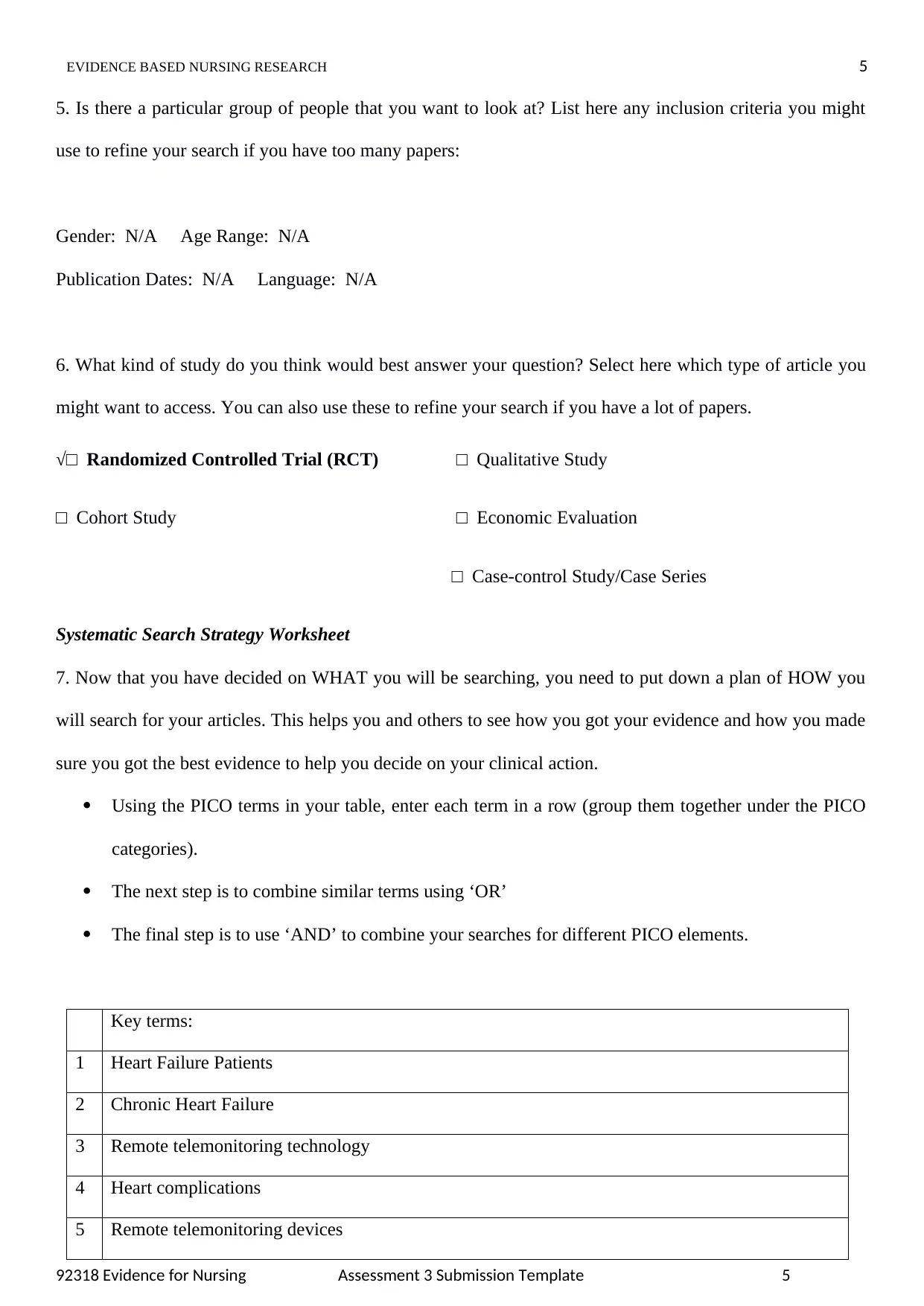
EVIDENCE BASED NURSING RESEARCH 5
5. Is there a particular group of people that you want to look at? List here any inclusion criteria you might
use to refine your search if you have too many papers:
Gender: N/A Age Range: N/A
Publication Dates: N/A Language: N/A
6. What kind of study do you think would best answer your question? Select here which type of article you
might want to access. You can also use these to refine your search if you have a lot of papers.
√□ Randomized Controlled Trial (RCT)
□ Cohort Study
□ Qualitative Study
□ Economic Evaluation
□ Case-control Study/Case Series
Systematic Search Strategy Worksheet
7. Now that you have decided on WHAT you will be searching, you need to put down a plan of HOW you
will search for your articles. This helps you and others to see how you got your evidence and how you made
sure you got the best evidence to help you decide on your clinical action.
Using the PICO terms in your table, enter each term in a row (group them together under the PICO
categories).
The next step is to combine similar terms using ‘OR’
The final step is to use ‘AND’ to combine your searches for different PICO elements.
Key terms:
1 Heart Failure Patients
2 Chronic Heart Failure
3 Remote telemonitoring technology
4 Heart complications
5 Remote telemonitoring devices
92318 Evidence for Nursing Assessment 3 Submission Template 5
5. Is there a particular group of people that you want to look at? List here any inclusion criteria you might
use to refine your search if you have too many papers:
Gender: N/A Age Range: N/A
Publication Dates: N/A Language: N/A
6. What kind of study do you think would best answer your question? Select here which type of article you
might want to access. You can also use these to refine your search if you have a lot of papers.
√□ Randomized Controlled Trial (RCT)
□ Cohort Study
□ Qualitative Study
□ Economic Evaluation
□ Case-control Study/Case Series
Systematic Search Strategy Worksheet
7. Now that you have decided on WHAT you will be searching, you need to put down a plan of HOW you
will search for your articles. This helps you and others to see how you got your evidence and how you made
sure you got the best evidence to help you decide on your clinical action.
Using the PICO terms in your table, enter each term in a row (group them together under the PICO
categories).
The next step is to combine similar terms using ‘OR’
The final step is to use ‘AND’ to combine your searches for different PICO elements.
Key terms:
1 Heart Failure Patients
2 Chronic Heart Failure
3 Remote telemonitoring technology
4 Heart complications
5 Remote telemonitoring devices
92318 Evidence for Nursing Assessment 3 Submission Template 5
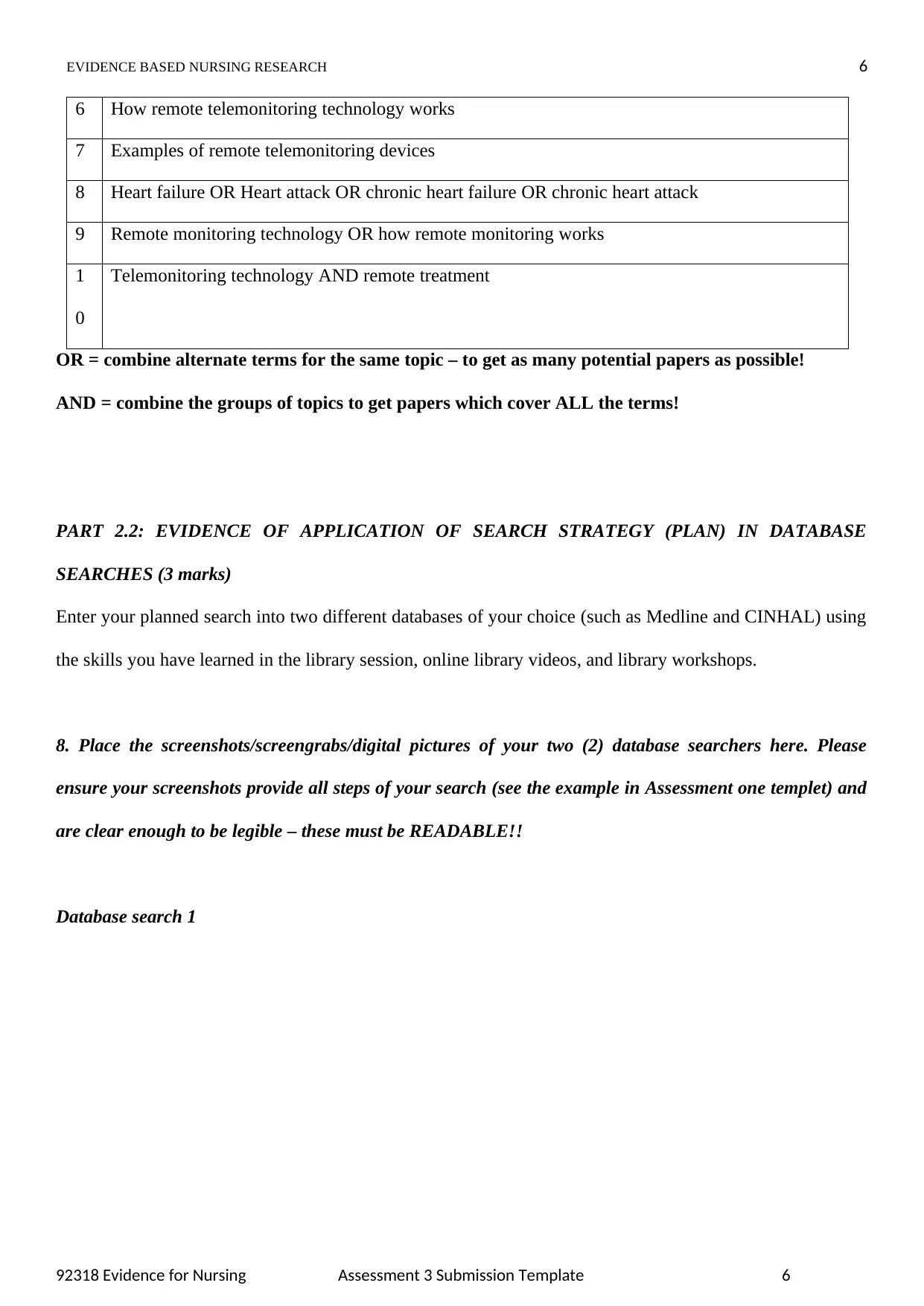
EVIDENCE BASED NURSING RESEARCH 6
6 How remote telemonitoring technology works
7 Examples of remote telemonitoring devices
8 Heart failure OR Heart attack OR chronic heart failure OR chronic heart attack
9 Remote monitoring technology OR how remote monitoring works
1
0
Telemonitoring technology AND remote treatment
OR = combine alternate terms for the same topic – to get as many potential papers as possible!
AND = combine the groups of topics to get papers which cover ALL the terms!
PART 2.2: EVIDENCE OF APPLICATION OF SEARCH STRATEGY (PLAN) IN DATABASE
SEARCHES (3 marks)
Enter your planned search into two different databases of your choice (such as Medline and CINHAL) using
the skills you have learned in the library session, online library videos, and library workshops.
8. Place the screenshots/screengrabs/digital pictures of your two (2) database searchers here. Please
ensure your screenshots provide all steps of your search (see the example in Assessment one templet) and
are clear enough to be legible – these must be READABLE!!
Database search 1
92318 Evidence for Nursing Assessment 3 Submission Template 6
6 How remote telemonitoring technology works
7 Examples of remote telemonitoring devices
8 Heart failure OR Heart attack OR chronic heart failure OR chronic heart attack
9 Remote monitoring technology OR how remote monitoring works
1
0
Telemonitoring technology AND remote treatment
OR = combine alternate terms for the same topic – to get as many potential papers as possible!
AND = combine the groups of topics to get papers which cover ALL the terms!
PART 2.2: EVIDENCE OF APPLICATION OF SEARCH STRATEGY (PLAN) IN DATABASE
SEARCHES (3 marks)
Enter your planned search into two different databases of your choice (such as Medline and CINHAL) using
the skills you have learned in the library session, online library videos, and library workshops.
8. Place the screenshots/screengrabs/digital pictures of your two (2) database searchers here. Please
ensure your screenshots provide all steps of your search (see the example in Assessment one templet) and
are clear enough to be legible – these must be READABLE!!
Database search 1
92318 Evidence for Nursing Assessment 3 Submission Template 6
⊘ This is a preview!⊘
Do you want full access?
Subscribe today to unlock all pages.

Trusted by 1+ million students worldwide
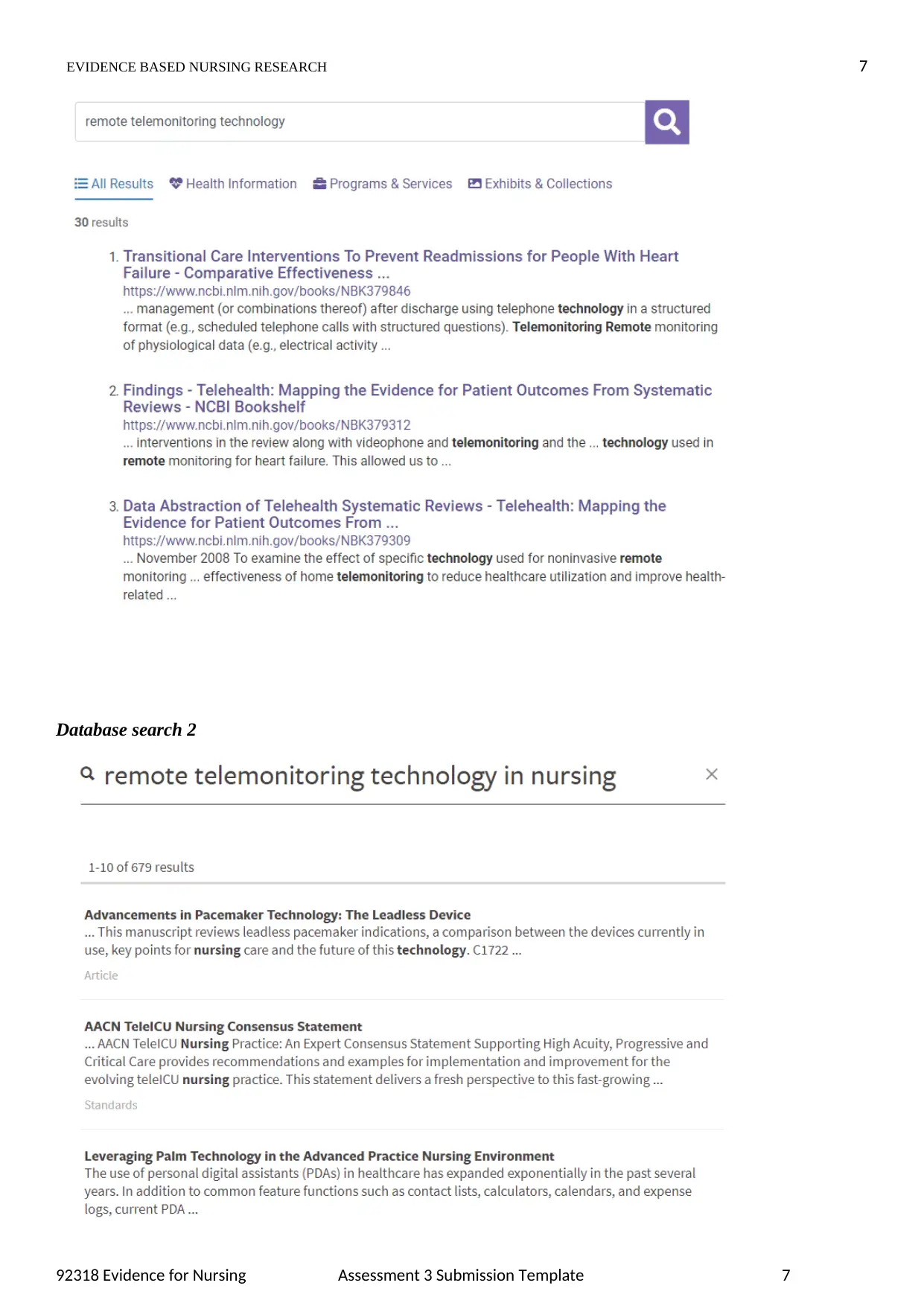
EVIDENCE BASED NURSING RESEARCH 7
Database search 2
92318 Evidence for Nursing Assessment 3 Submission Template 7
Database search 2
92318 Evidence for Nursing Assessment 3 Submission Template 7
Paraphrase This Document
Need a fresh take? Get an instant paraphrase of this document with our AI Paraphraser
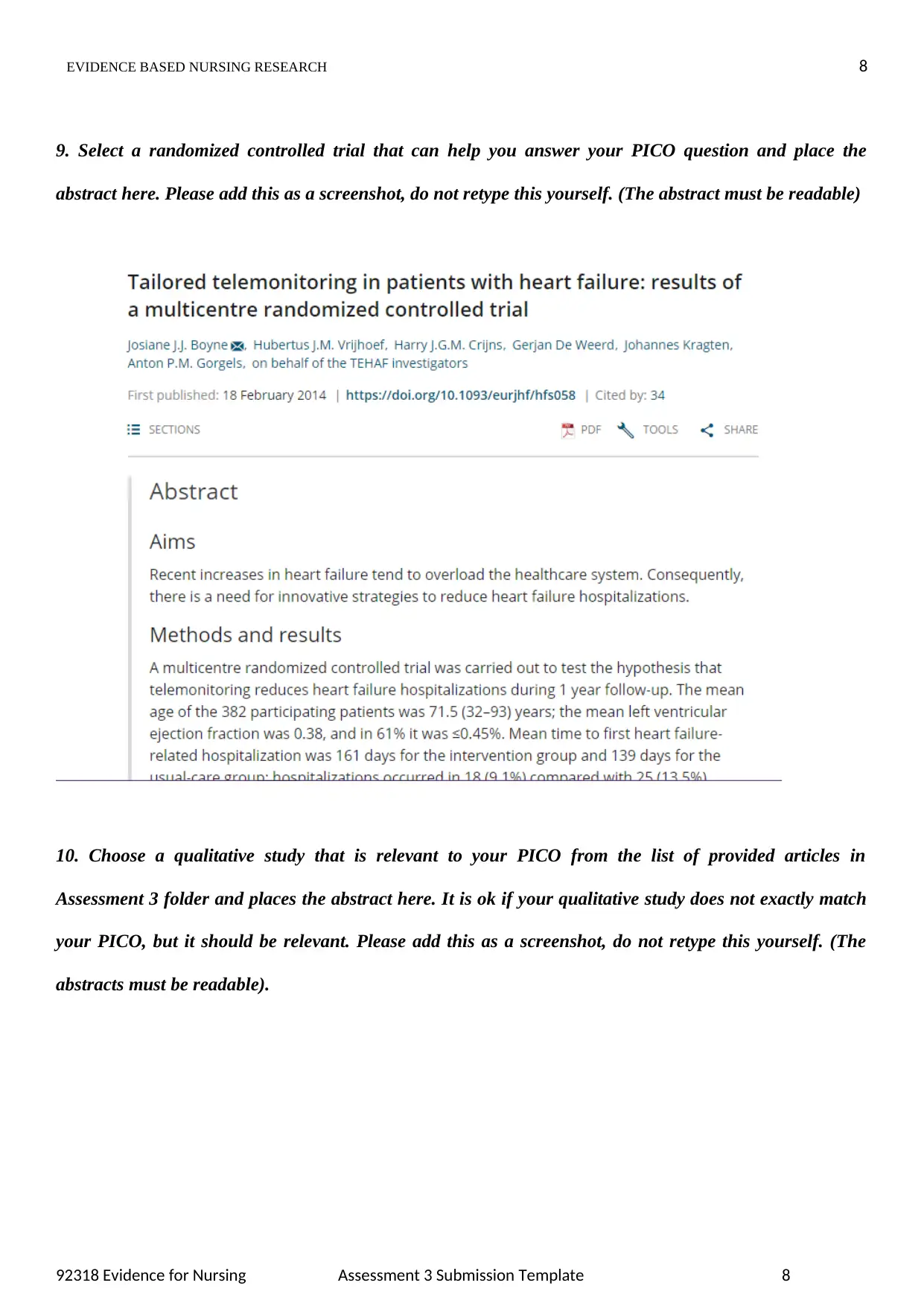
EVIDENCE BASED NURSING RESEARCH 8
9. Select a randomized controlled trial that can help you answer your PICO question and place the
abstract here. Please add this as a screenshot, do not retype this yourself. (The abstract must be readable)
10. Choose a qualitative study that is relevant to your PICO from the list of provided articles in
Assessment 3 folder and places the abstract here. It is ok if your qualitative study does not exactly match
your PICO, but it should be relevant. Please add this as a screenshot, do not retype this yourself. (The
abstracts must be readable).
92318 Evidence for Nursing Assessment 3 Submission Template 8
9. Select a randomized controlled trial that can help you answer your PICO question and place the
abstract here. Please add this as a screenshot, do not retype this yourself. (The abstract must be readable)
10. Choose a qualitative study that is relevant to your PICO from the list of provided articles in
Assessment 3 folder and places the abstract here. It is ok if your qualitative study does not exactly match
your PICO, but it should be relevant. Please add this as a screenshot, do not retype this yourself. (The
abstracts must be readable).
92318 Evidence for Nursing Assessment 3 Submission Template 8
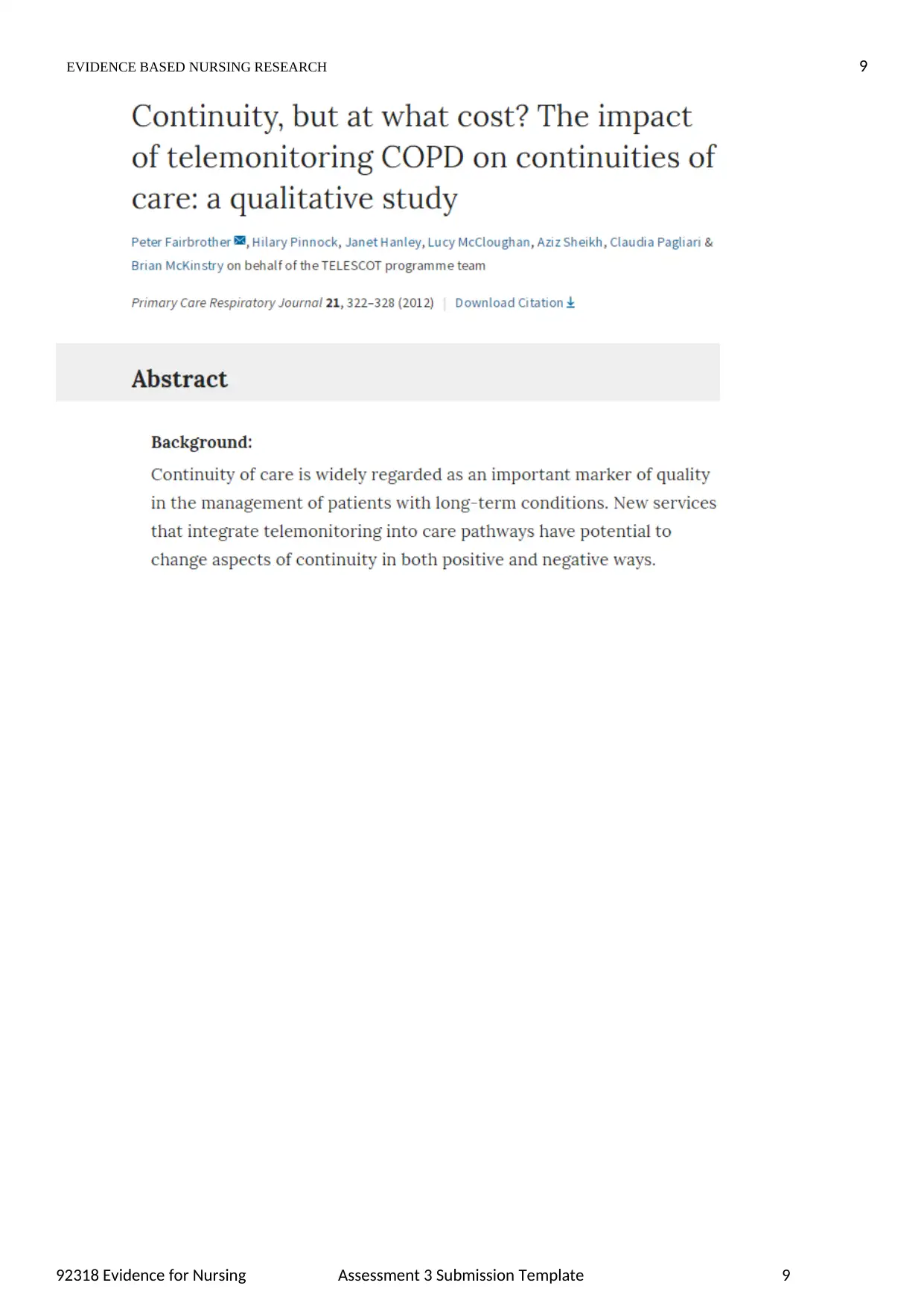
EVIDENCE BASED NURSING RESEARCH 9
92318 Evidence for Nursing Assessment 3 Submission Template 9
92318 Evidence for Nursing Assessment 3 Submission Template 9
⊘ This is a preview!⊘
Do you want full access?
Subscribe today to unlock all pages.

Trusted by 1+ million students worldwide
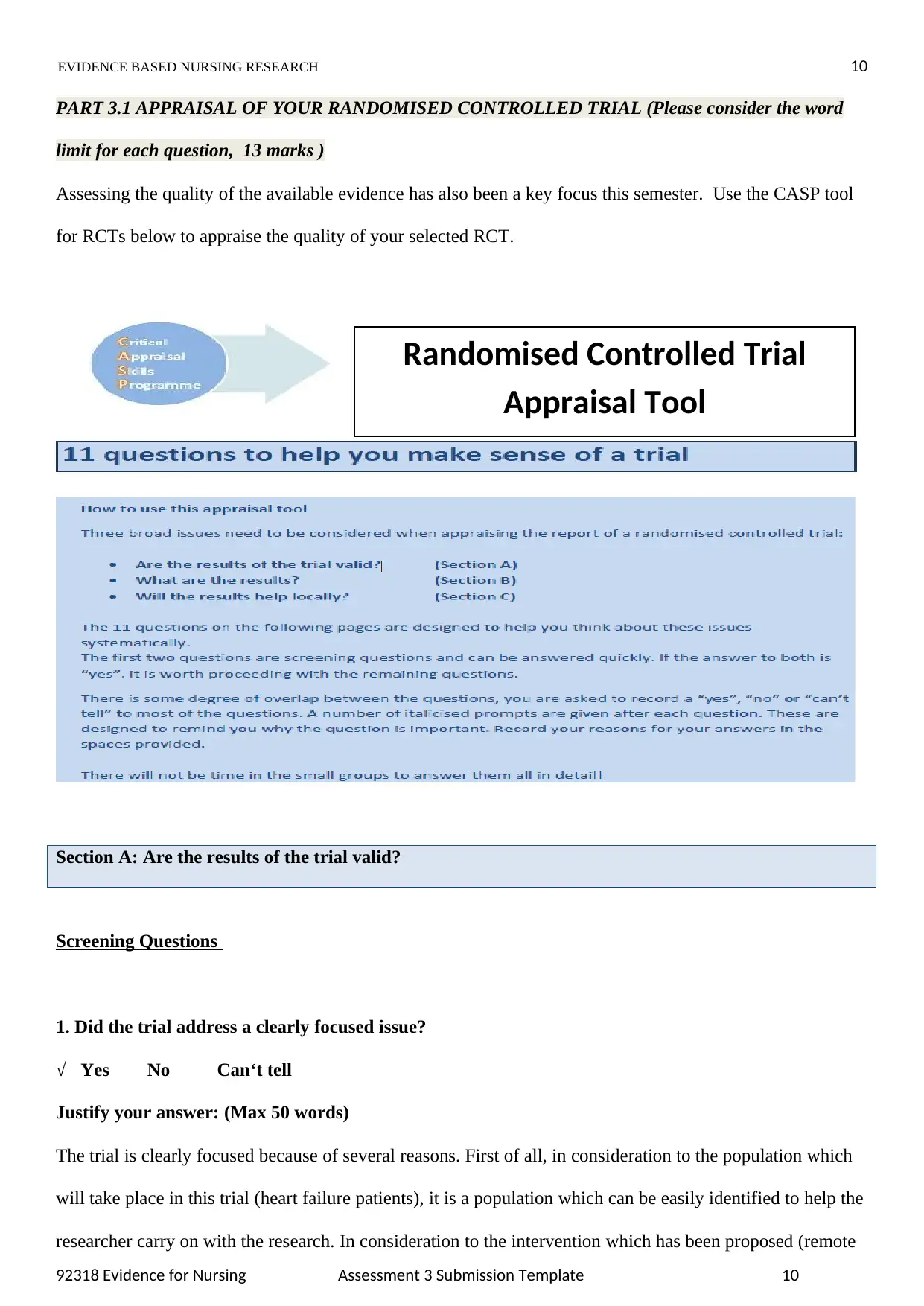
EVIDENCE BASED NURSING RESEARCH 10
PART 3.1 APPRAISAL OF YOUR RANDOMISED CONTROLLED TRIAL (Please consider the word
limit for each question, 13 marks )
Assessing the quality of the available evidence has also been a key focus this semester. Use the CASP tool
for RCTs below to appraise the quality of your selected RCT.
Section A: Are the results of the trial valid?
Screening Questions
1. Did the trial address a clearly focused issue?
√Yes No Can‘t tell
Justify your answer: (Max 50 words)
The trial is clearly focused because of several reasons. First of all, in consideration to the population which
will take place in this trial (heart failure patients), it is a population which can be easily identified to help the
researcher carry on with the research. In consideration to the intervention which has been proposed (remote
92318 Evidence for Nursing Assessment 3 Submission Template 10
Randomised Controlled Trial
Appraisal Tool
PART 3.1 APPRAISAL OF YOUR RANDOMISED CONTROLLED TRIAL (Please consider the word
limit for each question, 13 marks )
Assessing the quality of the available evidence has also been a key focus this semester. Use the CASP tool
for RCTs below to appraise the quality of your selected RCT.
Section A: Are the results of the trial valid?
Screening Questions
1. Did the trial address a clearly focused issue?
√Yes No Can‘t tell
Justify your answer: (Max 50 words)
The trial is clearly focused because of several reasons. First of all, in consideration to the population which
will take place in this trial (heart failure patients), it is a population which can be easily identified to help the
researcher carry on with the research. In consideration to the intervention which has been proposed (remote
92318 Evidence for Nursing Assessment 3 Submission Template 10
Randomised Controlled Trial
Appraisal Tool
Paraphrase This Document
Need a fresh take? Get an instant paraphrase of this document with our AI Paraphraser
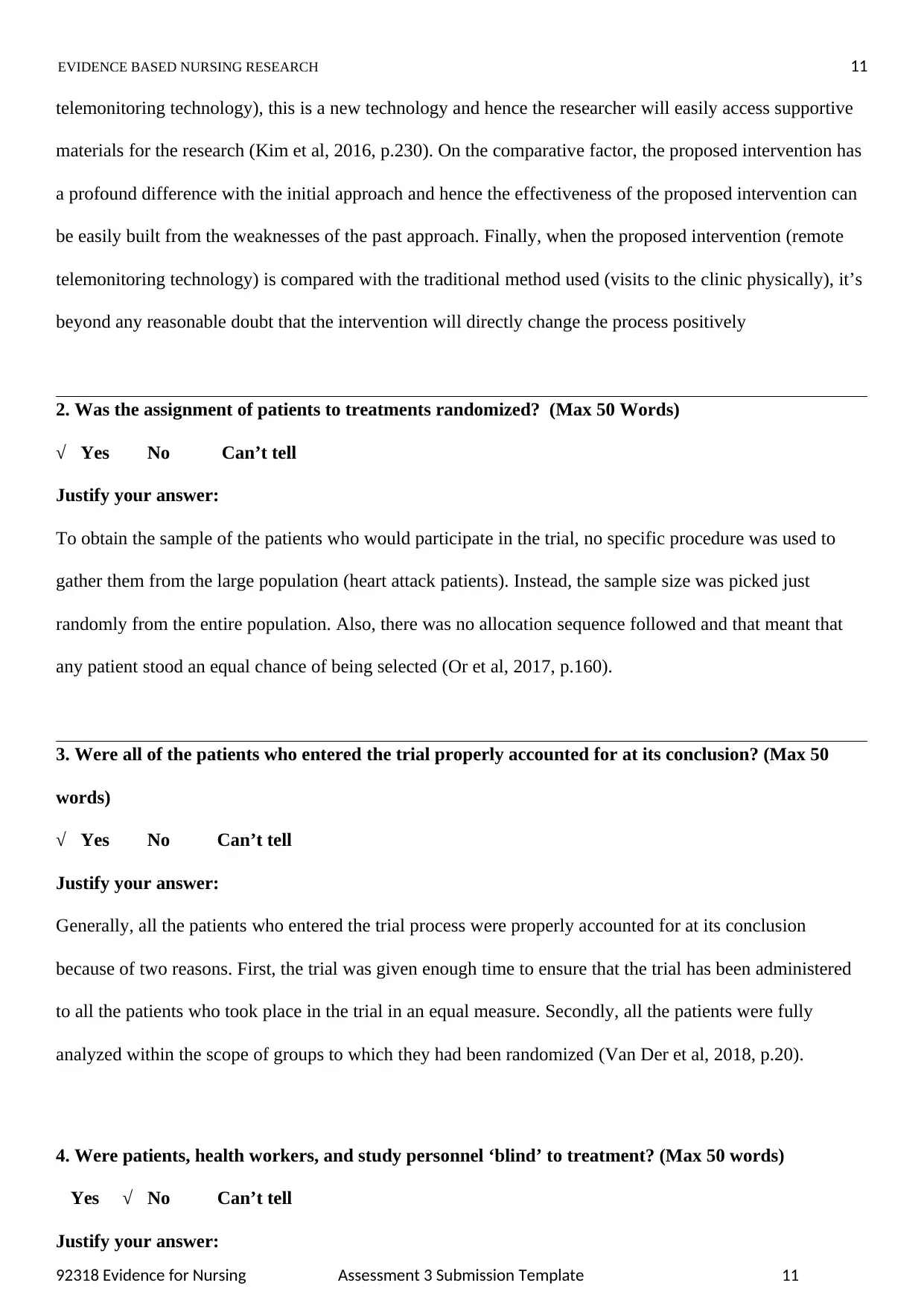
EVIDENCE BASED NURSING RESEARCH 11
telemonitoring technology), this is a new technology and hence the researcher will easily access supportive
materials for the research (Kim et al, 2016, p.230). On the comparative factor, the proposed intervention has
a profound difference with the initial approach and hence the effectiveness of the proposed intervention can
be easily built from the weaknesses of the past approach. Finally, when the proposed intervention (remote
telemonitoring technology) is compared with the traditional method used (visits to the clinic physically), it’s
beyond any reasonable doubt that the intervention will directly change the process positively
2. Was the assignment of patients to treatments randomized? (Max 50 Words)
√Yes No Can’t tell
Justify your answer:
To obtain the sample of the patients who would participate in the trial, no specific procedure was used to
gather them from the large population (heart attack patients). Instead, the sample size was picked just
randomly from the entire population. Also, there was no allocation sequence followed and that meant that
any patient stood an equal chance of being selected (Or et al, 2017, p.160).
3. Were all of the patients who entered the trial properly accounted for at its conclusion? (Max 50
words)
√Yes No Can’t tell
Justify your answer:
Generally, all the patients who entered the trial process were properly accounted for at its conclusion
because of two reasons. First, the trial was given enough time to ensure that the trial has been administered
to all the patients who took place in the trial in an equal measure. Secondly, all the patients were fully
analyzed within the scope of groups to which they had been randomized (Van Der et al, 2018, p.20).
4. Were patients, health workers, and study personnel ‘blind’ to treatment? (Max 50 words)
Yes √No Can’t tell
Justify your answer:
92318 Evidence for Nursing Assessment 3 Submission Template 11
telemonitoring technology), this is a new technology and hence the researcher will easily access supportive
materials for the research (Kim et al, 2016, p.230). On the comparative factor, the proposed intervention has
a profound difference with the initial approach and hence the effectiveness of the proposed intervention can
be easily built from the weaknesses of the past approach. Finally, when the proposed intervention (remote
telemonitoring technology) is compared with the traditional method used (visits to the clinic physically), it’s
beyond any reasonable doubt that the intervention will directly change the process positively
2. Was the assignment of patients to treatments randomized? (Max 50 Words)
√Yes No Can’t tell
Justify your answer:
To obtain the sample of the patients who would participate in the trial, no specific procedure was used to
gather them from the large population (heart attack patients). Instead, the sample size was picked just
randomly from the entire population. Also, there was no allocation sequence followed and that meant that
any patient stood an equal chance of being selected (Or et al, 2017, p.160).
3. Were all of the patients who entered the trial properly accounted for at its conclusion? (Max 50
words)
√Yes No Can’t tell
Justify your answer:
Generally, all the patients who entered the trial process were properly accounted for at its conclusion
because of two reasons. First, the trial was given enough time to ensure that the trial has been administered
to all the patients who took place in the trial in an equal measure. Secondly, all the patients were fully
analyzed within the scope of groups to which they had been randomized (Van Der et al, 2018, p.20).
4. Were patients, health workers, and study personnel ‘blind’ to treatment? (Max 50 words)
Yes √No Can’t tell
Justify your answer:
92318 Evidence for Nursing Assessment 3 Submission Template 11
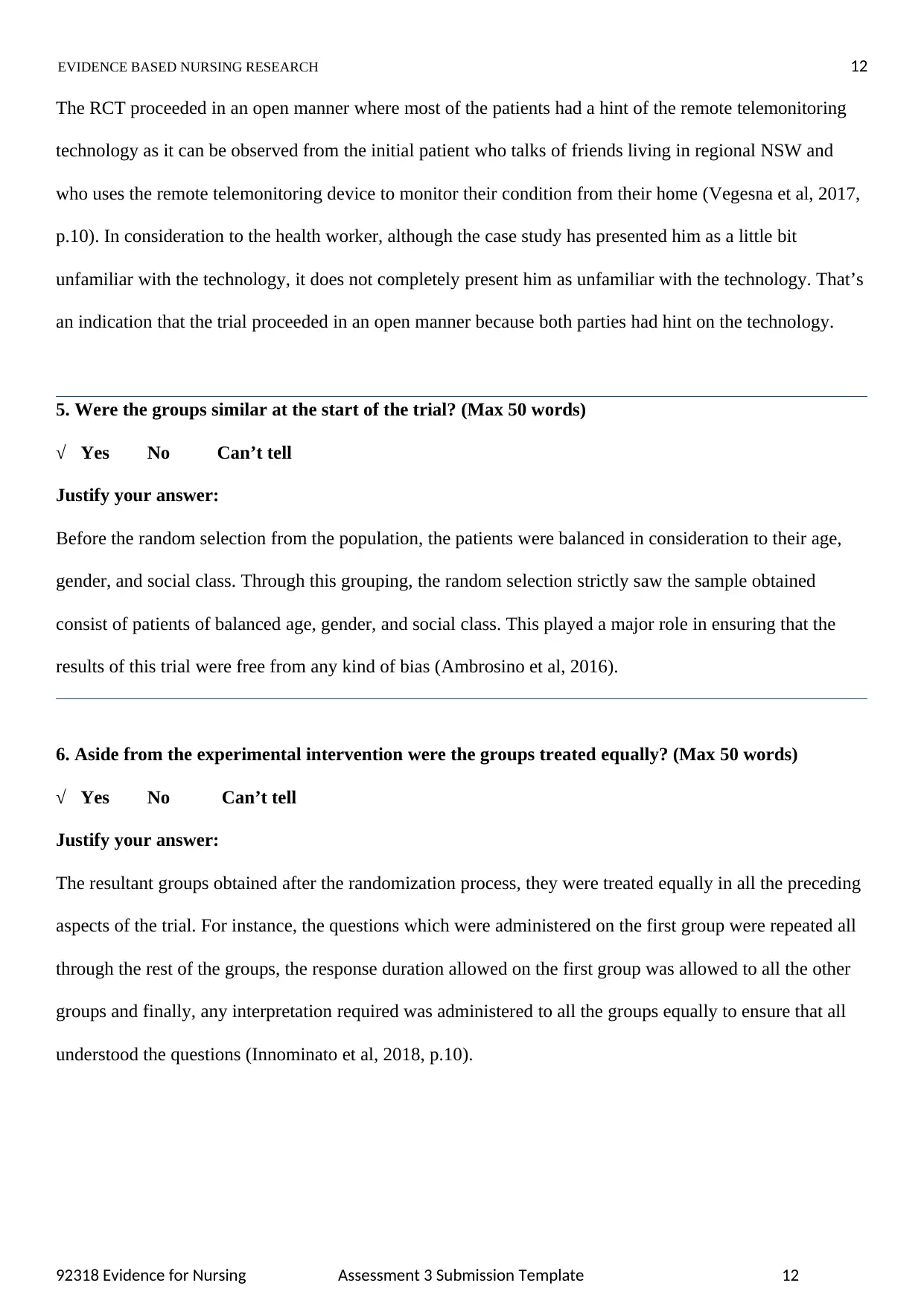
EVIDENCE BASED NURSING RESEARCH 12
The RCT proceeded in an open manner where most of the patients had a hint of the remote telemonitoring
technology as it can be observed from the initial patient who talks of friends living in regional NSW and
who uses the remote telemonitoring device to monitor their condition from their home (Vegesna et al, 2017,
p.10). In consideration to the health worker, although the case study has presented him as a little bit
unfamiliar with the technology, it does not completely present him as unfamiliar with the technology. That’s
an indication that the trial proceeded in an open manner because both parties had hint on the technology.
5. Were the groups similar at the start of the trial? (Max 50 words)
√Yes No Can’t tell
Justify your answer:
Before the random selection from the population, the patients were balanced in consideration to their age,
gender, and social class. Through this grouping, the random selection strictly saw the sample obtained
consist of patients of balanced age, gender, and social class. This played a major role in ensuring that the
results of this trial were free from any kind of bias (Ambrosino et al, 2016).
6. Aside from the experimental intervention were the groups treated equally? (Max 50 words)
√Yes No Can’t tell
Justify your answer:
The resultant groups obtained after the randomization process, they were treated equally in all the preceding
aspects of the trial. For instance, the questions which were administered on the first group were repeated all
through the rest of the groups, the response duration allowed on the first group was allowed to all the other
groups and finally, any interpretation required was administered to all the groups equally to ensure that all
understood the questions (Innominato et al, 2018, p.10).
92318 Evidence for Nursing Assessment 3 Submission Template 12
The RCT proceeded in an open manner where most of the patients had a hint of the remote telemonitoring
technology as it can be observed from the initial patient who talks of friends living in regional NSW and
who uses the remote telemonitoring device to monitor their condition from their home (Vegesna et al, 2017,
p.10). In consideration to the health worker, although the case study has presented him as a little bit
unfamiliar with the technology, it does not completely present him as unfamiliar with the technology. That’s
an indication that the trial proceeded in an open manner because both parties had hint on the technology.
5. Were the groups similar at the start of the trial? (Max 50 words)
√Yes No Can’t tell
Justify your answer:
Before the random selection from the population, the patients were balanced in consideration to their age,
gender, and social class. Through this grouping, the random selection strictly saw the sample obtained
consist of patients of balanced age, gender, and social class. This played a major role in ensuring that the
results of this trial were free from any kind of bias (Ambrosino et al, 2016).
6. Aside from the experimental intervention were the groups treated equally? (Max 50 words)
√Yes No Can’t tell
Justify your answer:
The resultant groups obtained after the randomization process, they were treated equally in all the preceding
aspects of the trial. For instance, the questions which were administered on the first group were repeated all
through the rest of the groups, the response duration allowed on the first group was allowed to all the other
groups and finally, any interpretation required was administered to all the groups equally to ensure that all
understood the questions (Innominato et al, 2018, p.10).
92318 Evidence for Nursing Assessment 3 Submission Template 12
⊘ This is a preview!⊘
Do you want full access?
Subscribe today to unlock all pages.

Trusted by 1+ million students worldwide
1 out of 21
Related Documents
Your All-in-One AI-Powered Toolkit for Academic Success.
+13062052269
info@desklib.com
Available 24*7 on WhatsApp / Email
![[object Object]](/_next/static/media/star-bottom.7253800d.svg)
Unlock your academic potential
Copyright © 2020–2025 A2Z Services. All Rights Reserved. Developed and managed by ZUCOL.





